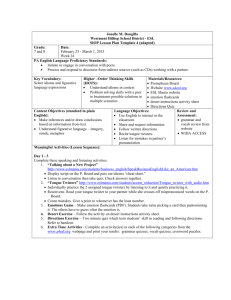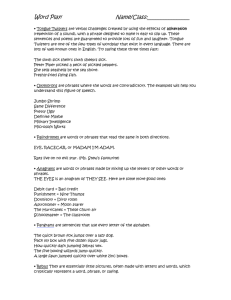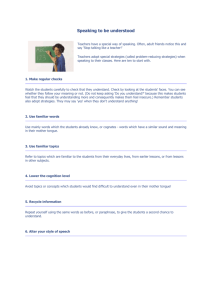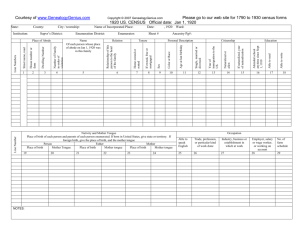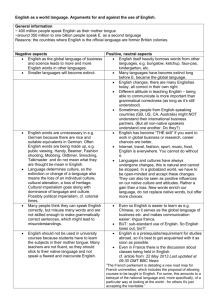The Importance of Voice
advertisement
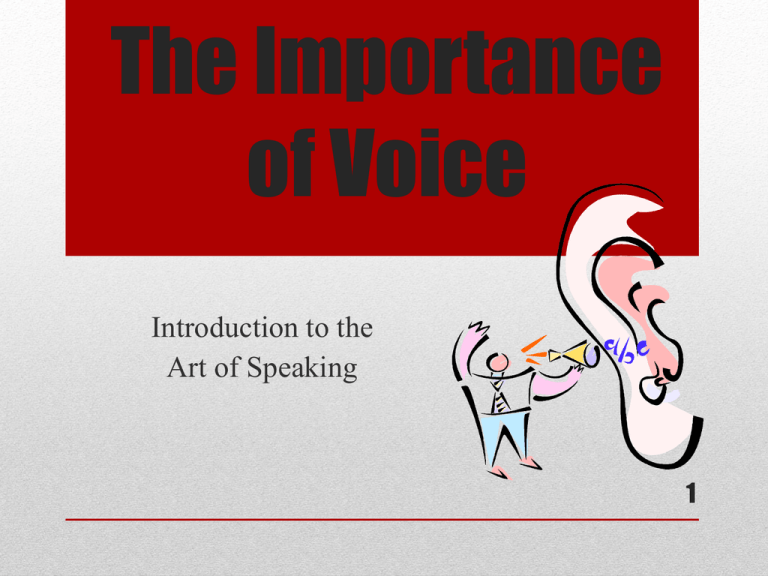
The Importance of Voice Introduction to the Art of Speaking 1 Benefits of diction exercises The specific benefits of diction/articulation exercises are: • strengthening and stretching the muscles involved in speech • bringing to your attention to speech patterns you have that may be less than perfect 2 Tips for Tongue Twister Diction Exercises: • Always start slowly and carefully. • Make sure the beginning and end of each word is crisp and avoid running the words together. • Repeat the phrase, getting faster and faster while maintaining clarity. If you trip over words, stop and start again. 3 Loosening the Tongue: • Mrs. Tongue lives in her house, the mouth. Every morning she mops it from ceiling to floor. First she sweeps her mop from right to left. • Run your tongue in a full circle around your cheek walls across the front of your top and bottom teeth. Repeat 3 times. 4 Loosening the Tongue: • Next she sweeps her mop from left to right. • Reverse the direction of the circle. Repeat 3 times. 5 Loosening the Tongue: • Now she dusts the furniture. • Sweep your tongue as rapidly as you can from side to side across the upper teeth. Repeat at least 10 times. 6 Loosening the Tongue: • Lastly she sweeps away the cobwebs from around the front door. • Stick the tongue out as far as you can and sweep it from right to left around the outside of your lips. Repeat 3 times, then reverse the direction and repeat 3 times. 7 Try these Tongue Twisters: • • • • • • • Literally literary. Jack the jailbird jacked a jeep. My cutlery cuts keenly and cleanly. The shrewd shrew sold Sarah seven silver fish slices. Sister Susie sat on the sea shore sewing shirts for sailors. Four furious friends fought for the phone. Five flippant Freshmen fly from France for Fashions. 8 Try these Tongue Twisters: • • • • • • Lucy lingered, looking longingly for her lost lap-dog. Reading and Writing are richly rewarding. Ten tame tadpoles tucked tightly in a thin tall tin. Two toads, totally tired, trying to trot to Tewkesbury. Red leather, yellow leather, red lorry, yellow lorry You know New York, You need New York, You know you need unique New York. 9 Try these Tongue Twisters: Peter Piper picked a peck of pickled peppers. If Peter picked a peck of pickled peppers, Where’s the peck of pickled peppers that Peter Piper picked? 10 Try these Tongue Twisters: Betty bought a bit of butter, but she found the butter bitter, so Betty bought a bit of better butter to make the bitter butter better. 11 Try these Tongue Twisters: Moses supposes his toses are roses, but Moses supposes erroneously, for nobody’s toeses are posies of roses as Moses supposes his toses to be. 12 Try these Tongue Twisters: From Gilbert and Sullivan’s The Pirates of Penzance (the equivalent of a triathalon!): I am the very model of a modern Major-General; I’ve information vegetable, animal, and mineral; I know the Kings of England, and I quote the fights historical, from Marathan to Waterloo, in order categorical; I’m very well acquainted too with matters mathematical, I understand equations, both simple and quadratical, about binomial theorem I’m teeming with a lot o’ news, with many cheerful facts about the square of the hypotenuse. I’m very good at integral and differential calculus, I know the scientific names of being animalculous, In short, in matters vegetable, animal, and mineral, I am the very model of a modern Major-General. 13 Vocal Variety 14 Vocal Variety The fastest way to bore your audience is to speak in a monotone with a lack of vocal variety. If you don’t deliver your speech in an interesting way, then it doesn’t matter how good your content is or how well-prepared you are. The speech will be a failure! 15 Vocal Variety Vocal variety is achieved through combining pitch, tone, volume, and rate. 16 Pitch: The high and low range of your voice. 17 Tone: Emotional content carried by our voices. 18 Volume: How loudly or quietly you speak 19 Rate: Speaking pace 20 Vocal Variety Practice Are you speaking to me? Are you speaking to me? Are you speaking to me? Are you speaking to me? Are you speaking to me? 21 To Practice Pitch: • Practice swinging between your upper and lower range. Using the text provided below, read aloud. The first sentence is up; the second sentence is down. Continue seesawing for at least a minute. • “Laptops are not teachers. New technology in the classroom—what could be wrong with that? In Idaho’s case, almost everything. Superintendent Tom Luna’s plan isn’t really about integrating new learning tools into the curriculum. He’s using what he calls the “miracle of technology” to cut teachers’ jobs or salaries, and increase class size. Give every high school student a laptop by 2015 and take away the educators—they won’t notice any difference!” (NEA Today, Summer 2011) 22 • Now make the see-saw work faster. Read the same passage but this time it is three words up and three words down. Play with variations! • “Laptops are not teachers. New technology in the classroom—what could be wrong with that? In Idaho’s case, almost everything. Superintendent Tom Luna’s plan isn’t really about integrating new learning tools into the curriculum. He’s using what he calls the “miracle of technology” to cut teachers’ jobs or salaries, and increase class size. Give every high school student a laptop by 2015 and take away the educators—they won’t notice any difference!” (NEA Today, Summer 2011) 23 Say the sentences below in your high, middle, and low pitch range. Note what happens to the intensity and the way you perceive the emotional content of the sentences. There will be a distinct variation between each. Her grandmother died yesterday. I want a new car. This dinner is delicious. People should love their neighbors as themselves. 24 To Practice Tone: Repeat the words “ham sandwich” in as many varying ways as you can. For example, say it angrily, happily, sadly, lovingly, despairingly, laughingly, importantly, slyly, snidely, shyly... Take two opposite emotions, for example: happy-sad or angry-contented. Still using the words “ham sandwich”, start with one emotion and gradually switch to the other. Make sure you grade the switch. Unless we’re very, very excitable emotionally, we seldom alter suddenly from one to another. Take a page from the telephone book and select a style or emotion and read aloud whatever is there. Sustain a feeling for a minute. This gives you time to get into it. Listen to yourself to make sure you are filling those words with the appropriate emotion. 25 To Practice Volume: • • • Practice breathing to use your diaphragm. Stand in front of a mirror. Make sure your feet are a comfortable shoulder width apart. Pull yourself up straight and place one hand on your stomach. Breathe in. You should feel your stomach rising and then breathe out. This time your stomach falls. Watch your shoulders. If they rise and fall noticeably, you are most likely breathing off the top of your lungs. Try until you can feel a definite rise and fall of your stomach. Maintain the breathing technique outlined above while adding voice. Practice greeting yourself at ever increasing distances from the mirror. “Hello, Laurie” is right up close. Take two steps back and repeat. Now take more steps back and so on. Stand in front of your mirror breathing easily. On your out breath begin a series of Ha-Ha-Ha-Ha’s until all your breath is used. Take an in breath and start again. Vary your laughter. Make it louder, make it quiet, and then build it up again. Repeat until you are laughing loudly 26 and easily without any strain.
